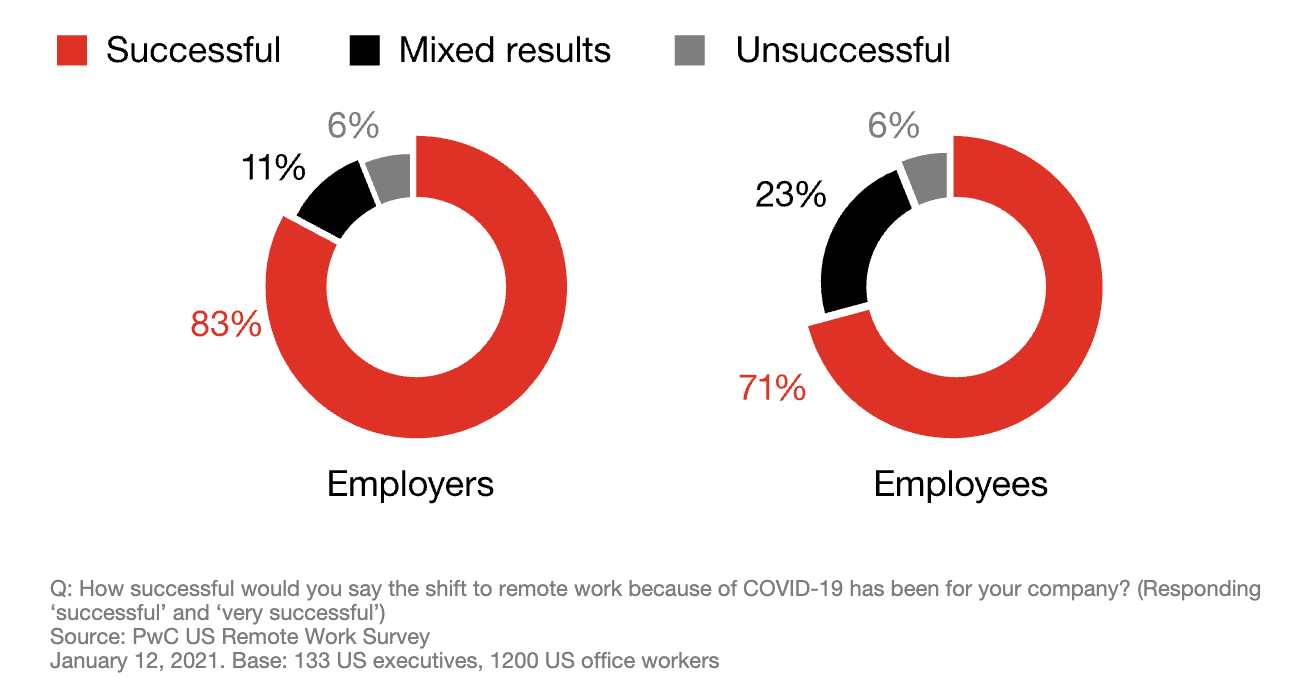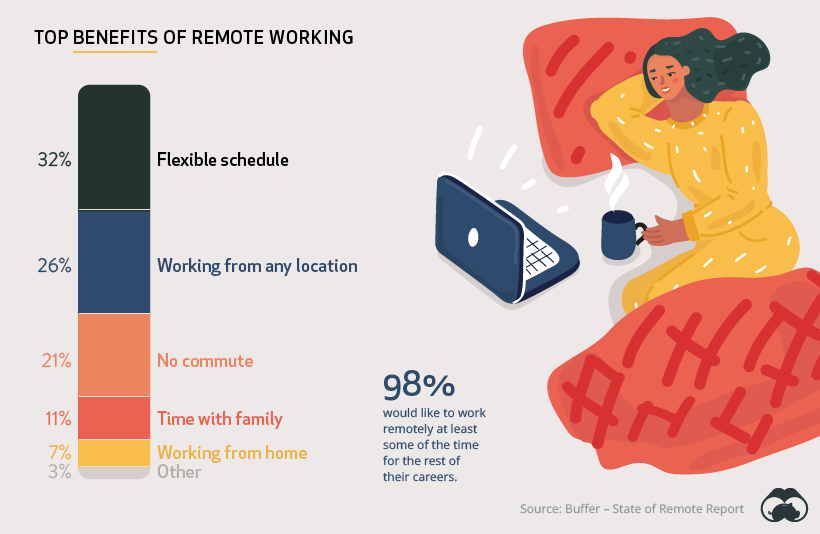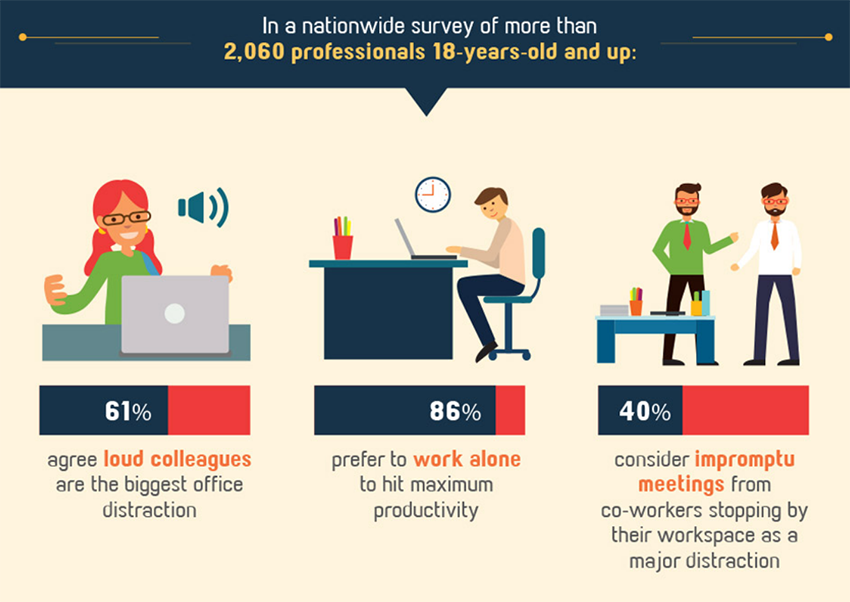In recent years, there has been a cultural shift in what constitutes an appropriate work environment. This shift was exacerbated with the onset of the global coronavirus pandemic, which saw the majority of businesses going remote in response to the onset of national lockdowns.
Out of necessity, businesses operating in industries like real estate and health care found ways to adapt to a remote lifestyle that allowed them to continue serving patients and clients, while keeping employees safe. Office workers found themselves trying to adapt to virtual and home office environments as working from home replaced the daily office grind.
With more than half of employers (55%) expecting some sort of remote work after COVID’s over, it’s crucial that businesses evaluate the pros and cons of working remotely today.
In this article, we’ll examine all things remote work. We’ll cover:
- What does working remote mean?
- How do people work remotely?
- State of remote work
- Pros of working remotely
- Cons of telecommuting
- What is the best way to work remotely?
- Life after COVID-19: Is remote work here to stay?
Ready? Let’s dive right in.
What does working remote mean?
Remote work refers to a style of working that enables professionals to work outside of traditional office environments. Instead of commuting to the office every day, remote workers can successfully execute their job-specific roles from anywhere they please.
A range of professionals can opt for the remote lifestyle. Full-time or part-time employees, contractors, freelancers, or anyone else capable of carrying out their work-related tasks and responsibilities without being present in an office space or other on-site workspace can effectively work remotely.

Is it working remote or working remotely?
Working remote suggests that the employee is remotely located. Often, this means in another city or a different country altogether. For example, a web developer located in Australia might work for an ecommerce business in the United Kingdom. It implies that the employee is located too far from the company to be present in the workplace.
Working remotely has a similar meaning, but suggests that an employee is doing it temporarily. For instance, while traveling, on a business trip, or in unprecedented circumstances—like the COVID-19 pandemic. A human resources professional, for example, might have been sent abroad to a conference, but is working remotely by answering emails on the go.
However, the distinction between the two terms is blurred, which is why they often intend the same meaning. In fact, remote work has become a pretty complicated term in today’s world. You might have even heard remote working referred to as telecommuting or remote jobs advertised as “flexible jobs.” They all boil down to the same thing: you don’t have to be present in the office to go to work.
Nowadays, people aren’t just remote working from their homes. Where the term “working from home” is limiting in its application, “work from anywhere” is a more fitting alternative to describe the current behaviors of remote professionals.
Why do we work remotely?
Often, people seek remote jobs for reasons relating to lifestyle. Remote workers can benefit from leaving behind the 9-to-5 working day in favor of a flexible schedule that gives them more control over the hours they work.
Remote employees can effectively work from anywhere, be it from home or a beach in a far-off country, as long as they have an internet connection with good connectivity and bandwidth. The expenses and time spent on commuting are reduced, allowing employees to spend more time with their families or cultivating their hobbies.
However, employees aren’t the only ones who might choose to go remote. Companies can also reap plenty of the benefits that flexible work yields. Namely a happier, healthier, and more satisfied workforce. And, happy employees tend to equal higher productivity levels and better engagement. Which, in turn, leads to better business results.
How do people work remotely?
Often working remotely is used synonymously with working from home. However, that’s not the whole story. Remote work is a much broader practice than that.
There are plenty of ways employees can work remotely. That’s what makes it so flexible. When there’s no obligation to be physically present in an office or other on-site workplace, people can choose to work whenever—and wherever—is most convenient for them.
Sure, often that does mean working from the comfort of our home—from a home office, the kitchen table, or even the couch. For 80% of people, their homes are their default remote work location.
Other people might choose to work from local coffee shops, purchasing several cappuccinos throughout the day so as not to overstay their welcome.
Many opt to work from co-working spaces. These communal office-like spaces are great spots for freelancers, as they’re often hubs of productivity and community (with fast Wi-Fi) and provide plenty of networking opportunities for remote professionals.
Who can telecommute?
It’s a common misconception that the majority of jobs can’t be done remotely. When the global pandemic forced previously office-centered industries to operate remotely, businesses everywhere realized that going remote was possible—it just required the right tools and a touch of creativity.
If you’re unfamiliar with the numerous digital tools that can facilitate remote teamwork, then you’re probably wondering how certain jobs can translate to a remote position. Of course, some jobs simply can’t be carried out remotely.
For example, people working in sales, construction, transportation, production, installation, or service can’t always carry out their work tasks remotely. That being said, in today’s digital age, many jobs can be carried out at a distance using technology to collaborate and stay connected with coworkers, clients, and stakeholders.
Anyone on the lookout for a remote work opportunity has plenty of options. Remote sales jobs, remote customer service roles, remote product management supervisors, remote digital marketing jobs, the list goes on.
What’s more, the list is growing longer every day, as technological advances and enhanced project management tools make it increasingly possible to work from anywhere with an internet-connected device.
Nowadays, previously location-dependent roles (for instance, product designer roles, quality assurance personnel, or data science jobs) can be successfully carried out remotely.
Some jobs have even sprung up as a result of shifts in technology and the global work environment. For instance, you can be a virtual assistant, local SEO strategist, or marketing manager for a company located halfway across the world.

State of remote work
Remote work is quickly becoming the new normal. It’s no longer a lifestyle 9-to-5 office workers can merely long for. In today’s digital world, it’s right there for the taking.
So what’s the general consensus on working remotely?
It looks pretty good, we’d say. Buffer’s 2020 State of Remote Work found that 98% of respondents working remotely would like to continue to do so (at least partially) for the rest of their career. Moreover, 97% said they’d recommend remote work to others.
According to data collected by Flexjobs, before the pandemic (2005–2017) there was a 159% increase in the number of people telecommuting in the US. Flexjobs also estimated that 3.4% of the United States workforce were already working remotely before the pandemic struck. By June 2020, this percentage had skyrocketed to 42%.
Of course, this dramatic rise came about as a result of global shutdown measures to combat the pandemic, which meant companies across industries had to shut down their office and tell their employees to work from home.
The sudden shift to working remotely went down well with most employees and employers. A study by PwC revealed that 83% of employers reported the shift to remote work as being successful. Moreover, 55% expected some form of remote work to continue once the COVID crisis is over.

Source
Pros of working remotely
There are many benefits of working remotely. Let’s take a deeper look into some of the lifestyle and performance perks that working from anywhere can provide.
1. More flexibility
Out of all the remote work benefits, this is the main contender. 32% of remote workers report that a flexible schedule is the biggest perk. If you were asked the question “Why is remote work important to you?” in a job interview, this is likely to be your go-to answer.
The 9-to-5 office environment isn’t for everyone. Working remote allows employees to work anytime and anywhere they want. This is a huge pro for many people who feel they don’t have time to tend to other important life responsibilities when they have to remain in the office for the majority of daylight hours.
Simple things like time spent taking the kids to school or attending a scheduled doctor’s appointment can become complicated when working hours come into play. Freeing employees up to work when it suits them best is a win-win situation. Not only does it result in less stressed employees, but those employees are also more likely to perform at their best during the hours they choose to work.
It’s likely that companies that hire for remote positions have also caught on to the benefit of increased flexibility. By meeting employee needs, businesses can improve employee satisfaction, boost productivity, and reduce turnover. Moreover, hiring remote means employers can hire across time zones. Hiring employees in different countries can be a huge bonus for companies that provide services or customer support on a global scale.
That being said, remote work requires excellent time management skills. Staying on schedule and keeping track of hours can be challenging when you’re not adhering to pre-set hours. There are numerous time management strategies and time tracking tools that you can provide to remote employees to ensure they are using their time wisely.

Source
2. Cost savings for employers and employees
Whether you run a startup, small business, or an enterprise, the costs of operating a business can quickly add up. From renting office spaces to investing in on-site equipment and software, running a business is no cheap feat.
Remote work can save money for organizations and employees. According to a report by Global Workplace Analytics, businesses can save up to $11,000 each year by reducing—or eliminating entirely—the time employees need to be present in-person.
Moreover, the costs associated with simply going to work can be huge for office workers. Factoring in the costs of commuting, parking, and money spent on lunch, employees stand to save up to $4,000 per year when they transition to a remote job.
Investing in a unified communications (UC) solution like RingCentral Office® takes advantage of cloud technology to mitigate the costs of on-site hardware and software and the costs associated with traveling to and from the office. Instead, remote team employees can tune into virtual meetings by joining a video call or work on the go from their desktop or mobile app on a portable device.
3. Increased productivity
Increased productivity is one of the major benefits of working remotely. Giving employees a say in when, how, and where they work can be hugely empowering. This flexibility leads employees to feel more satisfied with their jobs, work more productively, and ultimately remain loyal to their employers.
Those unfamiliar with remote work might wonder how working from a home office, cafe, or co-working area could result in higher productivity levels. What about all the distractions? Kids, pets, social media? To prove this point, we’ll let the statistics do the talking.
- In a survey by Flexjobs, 95% of respondents reported their productivity as higher or the same when they work at home. Moreover, 51% reported that they felt more productive.
- 86% prefer to work alone to achieve maximum productivity.
- A Boston Consulting Group study found that 75% of remote employees report maintaining or improving productivity on individual tasks, with 51% reporting the same about collaborative tasks.
- A study by Stanford University found that increased productivity while working remotely leads up to a full extra day of work each week.
Office workers often plug in and listen to music or a podcast to block out noisy environments or coworkers who won’t stop talking. Outside the office environment, it’s much easier to remain focused on the task in front of you. Remote workers can increase productivity through:
- Fewer interruptions and less exposure to office politics
- More focused time with the help of productivity tools and strategies
- A quieter and more comfortable workspace
This increased productivity leads to better overall performance, which in turn, leads to higher engagement levels and better business results.

Source
4. Better work-life balance
Life isn’t all about work. Unfortunately, time spent commuting to and from the office as well as in the office quickly adds up. Work can easily take over our lives.
Working remotely can provide employees with up to 105 hours of extra leisure time per year. This equals out to a few more hours of spare time a week that can be spent with family or friends, enjoying hobbies, or pursuing other opportunities.
What does this all add up to? A better work-life balance.
Despite its challenges and pitfalls, remote workers report a Workforce Happiness Index of 75 out of 100, compared with 71 out of 100 for office workers. Overall, flexible jobs lead to better wellbeing and mental health, reduced absence rates, and less stress—so employees can perform at their best and enjoy themselves while doing so.
5. It’s a powerful recruitment tool
People have an overwhelmingly positive attitude to remote work.
One survey found that post-pandemic, 65% of respondents want to remain as full-time remote employees, while 31% would relish the opportunity of a hybrid role. Moreover, 27% of workers reported willingness to take a 10–20% pay cut if they had the opportunity to work for a remote company. The same survey found that 81% of job seekers would be more inclined to remain loyal to their employer if they could work remotely at least from time to time.
That kind of says it all, doesn’t it?
Companies that offer remote job opportunities have an advantage over their purely office-based counterparts. Remote work broadens the talent pool for businesses from local to global. Employers can create job postings and hire based on skill and talent, rather than geographical location.
Cons of telecommuting
Despite all its perks, telecommuting isn’t all fun and games. It poses its own set of challenges that remote employees must learn to overcome. However, with the right task management system and a robust communications and collaboration platform, remote teams can perform just as well as—if not better than—co-located ones.
1. Collaboration and communication challenges among remote teams
Jobs that require a huge amount of teamwork and collaboration can be more difficult to carry out remotely. Lack of the right tools, miscommunication, and different time zones bring extra challenges to working as part of a remote team.
It’s not like the office, where employees can readily brainstorm, interact, and collaborate in person, and anyone in a project manager role will tell you that collaborating remotely definitely requires creative solutions.
However, with a great remote work toolkit, it can work. More than work, it can boost teamwork and productivity to whole new levels.
RingCentral Office streamlines the process of communicating and collaborating among remote teams. With integrated team messaging, video conferencing, phone, and file sharing, remote team members can effectively communicate and work together. Remote teams can optimize workflows, manage tasks, and share files all via the centralized RingCentral app for desktop or mobile.
What’s more, RingCentral Office offers hundreds of business tool integrations. So, you can integrate your favorite project management tool, instant messaging app, CRM platform, and more to streamline your work processes. Did we mention that it’s an award-winning business communications solution?
2. Potential for isolation
One of the main worries that people job searching for remote positions have is that they could feel isolated. Working remotely does mean that you spend most of your time interacting with colleagues, clients, and managers through the screen. This lack of meaningful human interaction can lead to feelings of isolation and loneliness.
A robust unified communications platform like RingCentral is an invaluable communication tool for remote teams. With team messaging, phone, and file sharing, remote teams can stay connected throughout the day. What’s more, RingCentral offers high-quality (HQ) video conference capabilities to connect teams face-to-face.
That’s great, but what about the coffee machine bonding sessions, after-work drinks, or office parties that remote workers miss out on?
Companies working with remote teams will benefit from holding regular virtual office get-togethers and team building activities with video conferences. Whether it’s a coffee break during the day, a team training session, or a virtual Christmas party, video interactions can bolster team morale, build stronger working relationships, and reduce feelings of isolation among remote employees.

3. Decreased visibility
Some employees might be hesitant to accept a remote role because they feel it won’t provide them with visibility within an organization. Without spending time with managers or leaders, people working remotely might feel it’s more difficult to be rewarded for their work or offered opportunities for growth.
Many remote workers are wondering: how can their hard work be recognized in the absence of office interactions?
Again, this is where a robust cloud communications platform like RingCentral can help. By providing remote employees with a platform to connect with other company personnel in real time—via integrated message, phone, and video—you can ensure they feel valued and heard as part of your organization.
The increasing popularity of remote work has also transformed performance reviews. Plenty of companies are taking performance management remote and bridging the in-office communication gap by leveraging communications solutions.
4. Security issues
When employees aren’t all using the same server to work, communicate, and access sensitive data, it can create security concerns. Unsecured public networks can put important business data at risk and provide an opportunity for online activity to be monitored or eavesdropped on.
This might not matter when someone’s researching what to make for dinner, but when it concerns financial information and sensitive passwords, you can run into security issues. Those who work on the go in cafes, hotels, or airports will find it difficult to avoid these risks, which is why it’s a downside of telecommuting.
Luckily, solutions like RingCentral exist to provide the security your business needs to operate remotely. With seven layers of security, RingCentral gives remote teams the peace of mind they need to do their jobs without worrying about security risks.

What is the best way to work remotely?
In reality, there’s no “best way” to work remotely. It all depends on finding a routine that works for you. The internet is a treasure trove of advice that can make working remotely easier to manage for people who aren’t used to being in control of their time when it comes to working. In fact, we’ve already shared some of our favorite tips for working remotely.
Life after COVID-19: Is remote work here to stay?
Remote work has gone down well among employees and employers. So well, in fact, that global enterprises like Twitter announced that they’ll allow their employees to permanently work remotely.
Of course, some jobs require an on-site presence at least some of the time. This is why it’s looking increasingly likely that the global workforce is heading towards hybrid workplaces, where employees manage their time between working remotely and in the office.
A recent Gartner study reaffirms this assertion with its findings that 82% of company leaders plan to allow employees to work remotely post-COVID. This model provides the flexibility that people crave, while transforming the way employees interact with office spaces and bolstering a remote company culture.
One thing’s for sure: remote work isn’t going anywhere soon.

Source
Empower your remote workforce
Working remotely is no walk in the park. Although it comes with its pitfalls and challenges, the advantages to working from anywhere, or having the option to, outweigh the disadvantages. As we move deeper into a digitalized, globally connected world in the wake of the pandemic, organizations must weigh up the pros and cons of telecommuting.
Today’s dynamic workforce demands more flexibility and autonomy over how, when, and where they work. As a result, business leaders must effectively adapt their strategies to meet these needs and remain competitive in the shifting business landscape.
Unified communications solutions like RingCentral Office can help businesses—big and small—to work remotely. RingCentral is a robust platform that enables remote or hybrid teams to connect and collaborate through integrated communications, task management, and file sharing.
What’s more, it can be deployed and scaled in minutes. RingCentral grows as your business grows, empowering workers with the tools they need to succeed—remotely.
Looking For Startup Consultants ?
Call Pursho @ 0731-6725516
Telegram Group One Must Follow :
For Startups: https://t.me/daily_business_reads




